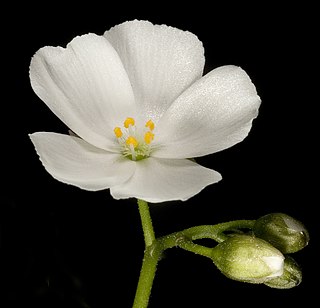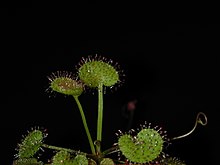
Drosera, which is commonly known as the sundews, is one of the largest genera of carnivorous plants, with at least 194 species. These members of the family Droseraceae lure, capture, and digest insects using stalked mucilaginous glands covering their leaf surfaces. The insects are used to supplement the poor mineral nutrition of the soil in which the plants grow. Various species, which vary greatly in size and form, are native to every continent except Antarctica.

Droseraceae is a family of carnivorous flowering plants, also known as the sundew family. It consists of approximately 180 species in three extant genera, the vast majority being in the sundew genus Drosera. The family also contains the well-known Venus flytrap and the more obscure waterwheel plant, both of which are the only living species of their respective genera. Representatives of the Droseraceae are found on all continents except Antarctica.

Drosera adelae, commonly known as the lance-leaved sundew, is a carnivorous plant in the genus Drosera that is endemic to Queensland, Australia.
The genus Drosera was divided in 1994 by Seine & Barthlott into three subgenera and 11 sections on the basis of morphological characteristics.
Drosera fimbriata, the Manypeaks sundew, is a perennial tuberous species in the genus Drosera that is endemic to Western Australia. It grows to 10 to 15 cm tall with two or three whorls of non-carnivorous leaves on the lower portion of the stem and 2 to 5 whorls of carnivorous leaves above that. It is native to a region mostly around Manypeaks but with populations near the Scott River and near Denmark. It grows in winter-wet sandy soils in heathland. It flowers in October.

Drosera platypoda, the fan-leaved sundew, is a tuberous perennial species in the genus Drosera that is endemic to south-west Western Australia. It grows 15 to 20 cm tall with a basal rosette of leaves with alternate cauline leaves along the stem. It is native to a region from Manjimup south-west to an area around the Scott River and east to Cape Riche. It grows in winter-wet sandy soils in heathland. It flowers in October.

Drosera porrecta is a tuberous perennial species in the genus Drosera that is endemic to Western Australia. It grows up to 45 cm tall. It is native to a region from Eneabba and Marchagee south to an area around Pinjarra, including the Darling Range and Mount Cooke. It grows in well-drained sandy soils and flowers from July to September.

Drosera subg. Ergaleium, collectively known as the tuberous sundews, is a subgenus of three sections of tuberous species in the genus Drosera. The three sections represent natural groups, including the rosetted species, the fan-leaved species, and the erect or scrambling species.

Drosera macrophylla, the showy sundew, is a perennial tuberous species in the genus Drosera that is endemic to Western Australia. It grows in a rosette with leaves 4 cm (2 in) long and 2 cm (1 in) wide. It is a common species east of Perth. It grows in loam soils. It flowers from June to October. D. macrophylla was first described by John Lindley in his 1839 publication A sketch of the vegetation of the Swan River Colony. In 1992, Allen Lowrie and Sherwin Carlquist described a new subspecies, D. macrophylla subsp. monantha, which is distinguished from D. macrophylla subsp. macrophylla by its single-flowered or rarely biflowered inflorescences. Subspecies monantha is abundant in the Bruce Rock/Merredin region.
Drosera rosulata is a perennial tuberous species in the genus Drosera that is endemic to southwest Western Australia. It grows in a rosette about 7 cm in diameter. It grows in sandy or clay soils on the margins of swamps. Its white flowers emerge in April to June. D. rosulata was first formally described by Johann Georg Christian Lehmann in 1844.

Drosera heterophylla, the swamp rainbow, is an erect perennial tuberous species in the carnivorous plant genus Drosera that is endemic to Western Australia. It grows in shallow water swamps or wet clay flats near granite outcrops and occurs in the vicinity of Perth and to its north. D. heterophylla produces small leaves along an erect stem that can be 10–30 cm (4–12 in) tall. It is the only species in the genus that produces many-petaled flowers. These white flowers emerge from June to September.
Drosera intricata is a scrambling or climbing perennial tuberous species in the carnivorous plant genus Drosera that is endemic to Western Australia. It grows in clay-sand soils on swamp margins, or other habitats that are seasonally wet. D. intricata produces small carnivorous leaves along a glabrous stem that can be 25–40 cm (10–16 in) tall. Its 3-12 yellow flowers emerge from September to October. It gains its species name, intricata, from its twining or winding habit.

Drosera menziesii, the pink rainbow, is an erect or scrambling perennial tuberous species in the carnivorous plant genus Drosera. It is endemic to Western Australia and grows in a variety of habitats, including winter-wet depressions, swamps, and granite outcrops in clay or peat sand soils or loam. D. menziesii produces small, circular carnivorous leaves along an undulating erect stem that can be .05–1.1 m (0.2–3.6 ft) high. Its pink flowers emerge from July to November.
Drosera moorei is a scrambling or climbing perennial tuberous species in the carnivorous plant genus Drosera. It is endemic to Western Australia and grows near granite outcrops in sandy loam. D. moorei produces small, circular, peltate carnivorous leaves along glabrous stems that can be 12–35 cm (5–14 in) long. Inflorescences have two to ten yellow flowers and bloom from September to October.
Drosera sulphurea, the sulphur-flowered sundew, is a scrambling perennial tuberous species in the carnivorous plant genus Drosera. It is endemic to Western Australia and is found in coastal areas in sandy loam, often among Cephalotus. D. sulphurea produces small, shield-shaped carnivorous leaves along stems that can be 40–60 cm (16–24 in) high. Yellow flowers bloom in September.

Drosera zigzagia is an erect perennial tuberous species in the carnivorous plant genus Drosera. It is endemic to Western Australia and is found on the margins of salt lakes in brown sandy loam, often associated with D. salina, Stylidium insensitivum, S. pulviniforme, Levenhookia leptantha, and Frankenia species. Drosera zigzagia produces small, solitary carnivorous leaves that alternate along a zigzag stem, which can be 5–7 cm (2.0–2.8 in) high. Yellow flowers are borne on 4–9-flowered inflorescences that bloom from August to September.

Drosera sect. Ergaleium is a section of 26 species that are erect or scrambling tuberous plants in the genus Drosera. This section represents a natural group and are taxonomically monophyletic.

Cylindropuntia prolifera, known by the common name Coastal cholla, is a species of cactus. In Australia it is called 'Jumping Cholla' because of it seeming to jump from outbreak to outbreak.

Australia has one of the world's richest carnivorous plant floras, with around 187 recognised species from 6 genera.












